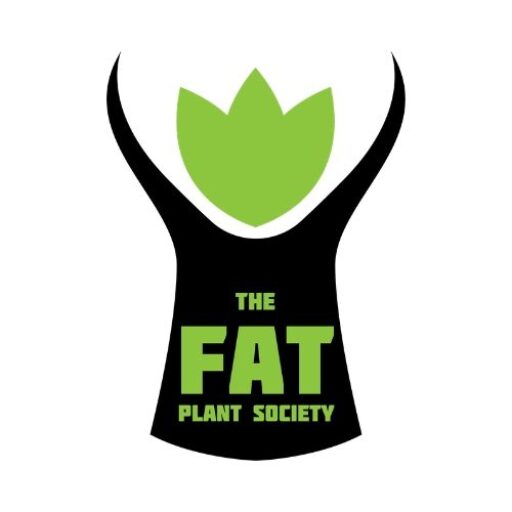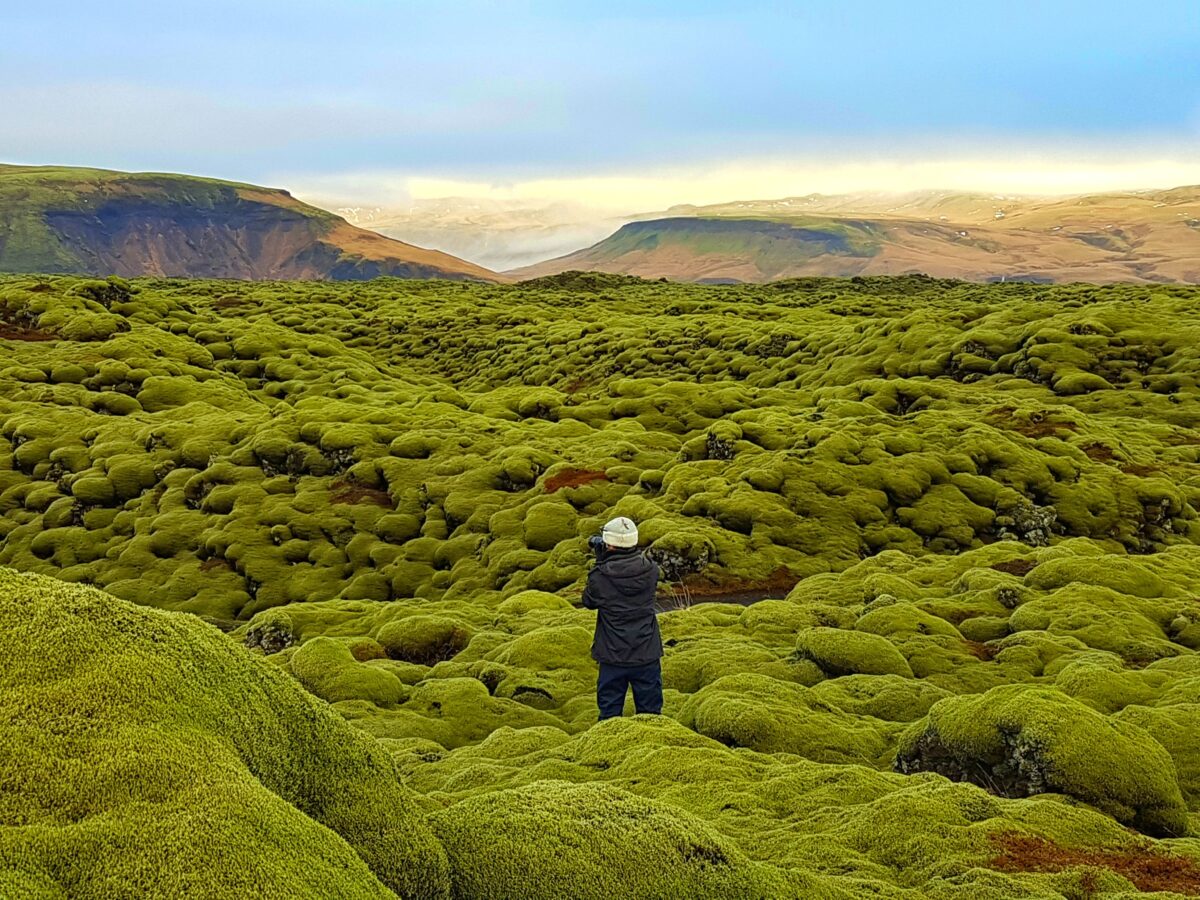You have likely seen at least one article on why moss is highly beneficial for the home and workplace but we’d like to share why green walls aka moss walls (see our previous post on the differences between the types of green walls) make excellent sense for schools and other educational environments.
We’ll go a little further than stress reducation, attention restoration, and psychological benefits–in fact, green walls can be the foundation for project-based curriculum and other learning opportunities.
Before we dive in though, we need to share that education is far more than a passing industry interest for us. I spent the first twenty plus years of my career in teaching and education. I began teaching in Beijing, China and then became a full time faculty (tenure track) member at Avila University, teaching advertising and public relations. From there, I went to Johnson County Library and where I had the infinite pleasure of working with Bradley Debrick (Early Literacy Coordinating Librarian) and Anna Foote (Youth Services and Continuing Education Consultant at Northeast Kansas Library System) to develop the 6by6: Ready to Read Program, also a brilliant book authored by the two of them. The 6by6: Ready to Read program just turned ten and the impact Bradley and Anna have made on early childhood literacy across the country (through libraries and library support organizations) is incalculable.
I share this because the experience and knowledge I gained in education from early childhood through post-secondary (I even substitute taught at the junior high and high school level) provided great insight into how the learning environment (including active learning with materials) has substantial impact on not only engagement but also, important outcomes in the learning environment.
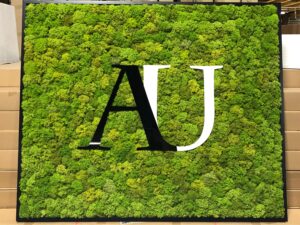
6-foot by 5-foot moss design by The Fat Plant Society for Augustana University, South Dakota.
The original draft of this article (published in 2018) is one of our most read articles (thanks for that by the way) and given that educational environments are passion projects for us (and that’s putting it mildly) we have been studying the approach and the work of Hollis and Miller Architects and here’s why:
What sets us apart is our ability to connect with educators to create a deep correlation to curriculum and instructional delivery methods. We believe so strongly in the importance of an integration of space and learning that we’ve dedicated a portion of our team to being a research-based resource for our clients as we work to create dynamic, interactive learning environments…
Education is transforming before our very eyes, and flexibility and adaptability will be paramount in creating environments that can support an ever-evolving approach to creating future-ready learners. We work with a research-based mindset, striving to know more about how the brain develops and operates and how learners respond to the context of space, curriculum, and fellow students.
You see, Hollis and Miller understand the vital role schools (of all types) play in our community and in our future. As Scott Barton (aka “Resident Professor at Hollis and Miller”) writes in his article, “School Sustainability Goes Way Beyond Green,”
When we start viewing schools as the true foundation of any community or neighborhood, we’ll begin approaching the buildings and facilities themselves with the question, “How will they stand the test of time?” Then we tap into the larger question of sustainability and begin to ensure we’re meeting the needs of our future generations—that we’re truly designing the future.
We could not agree more.
Going beyond LEED and Well Building Certifications, moss walls enhance sustainability by regulating temperature and serving as a kind of barometer of the air quality in the interior environment. For example, if the humidity in the space drops below 33-35%, the moss will become a little hard to the touch (in contrast to its normal, lush, softness) which is an indicator that the humidity level is too low, a problem thar actually does have health ramifications. As scholars, A V Arundel, E M Sterling, J H Biggin, and T D Sterling note in their article, “Indirect health effects of relative humidity in indoor environments:”
The majority of adverse health effects caused by relative humidity would be minimized by maintaining indoor levels between 40 and 60%. This would require humidification during winter in areas with cold winter climates.
-A.V. Arundel, E.M. Sterling, J. H. Biggin and T.D. Sterling
For example, the nearly 30-foot long moss wall we created and installed at HogsheadKC on the Country Club Plaza in Kansas City two years ago is as soft and lush today as it was the day we installed it. This indicates that the air quality in the restaurant is superior.
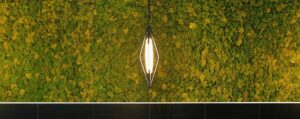
Nearly 30-foot long reindeer moss wall by The Fat Plant Society
Contrast the wonderful smell of food and cozy (hyggeligt) enviroment of HogsheadKC with that of our very own home. In the winter months, when the humidity level plummets, we note that the moss in our home begins to lose its soft, lush feel. That is an indicator to us that it is time to fire up the humidifiers. Whether you provide humidity through your HVAC or by placing humidifiers around your home, increasing that humidity level in the winter months can reduce instances of illness and improve lung and sinus health. It will also stop that annoying static we Midwesterners experience in the winter months.
Incidentally, cooking at home is a wonderful and very hyygeligt way to increase the humidity level in your home. It simply enhances the work the humidifier and moss are already doing and the moss actually absorbs scents (like the smell of fish and bacon) quickly so that your home smells, well, like a home.
Moss walls also gobble up VOCs (volatile organic compounds) in the air and reduce airborne pollutants and illnesses. You may have seen the moss wall in Germany that does the equivalent work of 275 trees a couple of years ago. When we recongize what living moss can do outdoors (and we recommend you visit Verdure for your exterior and living moss needs) with pollution, you can easily imagine what moss can do indoors and since The Fat Plant Society moss is dormant (meaning it does not require any watering, water basin, dirt, or misting) it is virtually maintenance-free.
A win for students, teachers, and parents to be sure.
But there are also ample learning experiences that accompany introducing moss and living plants into the eductational environment.
We were over the moon and crazy-excited to find this superior article by fellow midwestern folk on the benefits of plant life/green walls in educational environments. Michael B. McCullough, Michael D. Martin and Mollika A. Sajady in their superior perspective article, put it simply and succinctly, “Green walls have the potential to inspire critical thinking through a combination of project-based learning strategies and environmental education.”
Wait. What? So beyond the benefits that we already know and list for you below, there are numerous learning opportunities when greenery is introduced into the learning environment. In fact, the authors of this great piece have outlined a curriculum that incorporates project-based learning modules that interact with the wall.
“In conjunction with the passive health benefits of a green wall, project-based curriculum models can connect students interactively with indoor nature and have the potential to inspire real-world thinking related to science, technology, engineering, art, and mathematics fields within the indoor learning environment. Through a combination of these passive and interactive modes, students are connected to nature in the indoor environment regardless of weather conditions outdoors.”
Source: Implementing Green Walls in Schools, Michael B. McCullough1*, Michael D. Martin2 and Mollika A. Sajady3
Well, that just makes sense. Who doesn’t remember rainy or cold and snowy days when recess was held indoors and we were relegated to the classroom with maybe one philodendron on the teacher’s desk as the only green life in the room?
So in addition to making recess more fun and healthy, there are also ample STEM and STEAM learning opportunities. For those of you unfamiliar with STEAM, it adds the wonders of art and design to the science, technology, engineering, and math learning programs.
Do take a moment to visit Michael McCullough’s Project Sustainability site. The mission for Project Sustainability is clear:
Founded in 2013 by a Pediatrician and a Landscape Architect, Project Sustainability, a 501(c)(3) non-profit organization was created with primary goal to connect youth to nature and inspire them to be change-agents in sustainable development.
Since its founding, Project Sustainability has been active with research and developing an effective Artist in Residency program that combines nature with Science, Technology, Engineering, Art, and Mathematic fields through passive and interactive methods.
-Project Sustainability: Michael McCullough and Dr. Mollika Sajady
And as Biomimicry expert (collaborative partner and friend), Jamie Miller noted in a recent TEDTalk in Collingswood, “Dell put out a study last year saying that 85% of the jobs that will exist in 2030, do not exist today. There’s a huge transformation taking place and the next generation will actually be building the next economy. So I inspire that next generation to start thinking about their philosophies.”
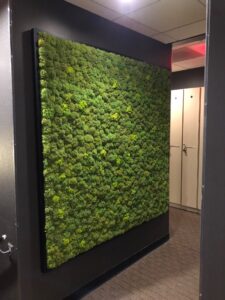
Custom moss installation by The Fat Plant Society for Bijin Spa, Prairie Village, Kansas. An example of a simple classroom moss installation.
Many educators (including Project Sustainability) have embraced both STEM and STEAM and the forward-thinking educators are thinking in terms of project-based, hands-on curriculum centered on the design of the classroom (or school as a whole) setting.
“It’s already been proven that being in the presence of plants can increase memory retention by around 20%, as well as improving people’s performance in a series of basic tests. This is thought to be due to the fact that their leaves and stems can absorb, deflect, and retract background noise, such as exterior traffic, children playing in the playground, and people talking in corridors.”
Source: The Benefits of Plants in Schools and Educational Facilities by phs.Greenleaf out of the U.K.
And here is where we explain that our moss walls function an awful lot like plants, but with virtually no maintenance. Though the moss we use (harvested in North Carolina and Kentucky) is preserved and dormant, it still absorbs both noise and air pollution.
And because moss covers a greater area (in terms of square footage) than living plants (at a lower cost), it actually absorbs as far more noise and air pollution than hundreds of plants. The photo below aptly illustrates how that is possible.
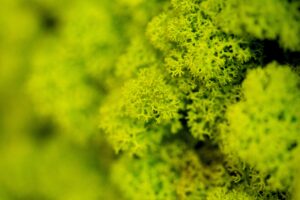
Reindeer moss close-up. Photo Credit: Alexandra Rhoades photography
The benefits of moss do not end with reduced noise and air pollution though, so we rely on the work and research of others to substantiate the statement that moss is very, very good for your health.
OutsideIn, a creative indoor greenery design firm out of New Zealand have conducted their own studies and they note, “While moss doesn’t have roots, once preserved, it will continue to draw moisture and airborne particles (including dust) out of the air. Moss walls can therefore contribute to cleaning indoor air naturally in a sustainable and far more economical way than air purifiers and ventilators.”
So moss walls give us a leg up on our health and also our learning…
Benefits
Improves classroom performance
The lovely folks at phs Greenleaf in the U.K. spell out for us what happens when just three plants are introduced into a learning environment. Student performance in spelling, math, reading and science improved by over 10% (a significant increase for those of us familiar with curriculum development and learning research).
A researcher in Taiwan found similar positive effects from greenery in the classroom. K.T. Han used surveys every two weeks to assess students’ emotions. He also collected objective information on students’ academic performance, health, and behavior and found that students in the experimental classroom (where plants were introduced) had significantly higher scores than the “control” classroom in terms of preference, comfort, and friendliness. Additionally, those in the experimental classroom had higher test scores on academic measures than those in the other classroom.
In addition to serving as a filter for distracting background noise, another explanation for why plant life can improve student classroom performance is because moss reduces levels of CO2 and VOCs (volatile organic compounds in the air). Studies explicate that students exposed to high levels, this can experience headaches, dizziness, and tiredness, all of which impact a student’s ability to concentrate and focus. And speaking of focus…
Reduces “directed-attention” fatigue
So this is cool–way back in the 1970s, USDA Forest Service provided funding for research on the effects of an outdoor challenge program in the wilderness in Michigan’s Upper Peninsula. That research spurred a series of investigations with findings that have influenced a generation of environmental psychologists.
“What grew out of that work was the influential theory of restorative environments outlined in such books as “With People in Mind: Design and Management for Everyday Nature” (Island Press, 1998). Drawing on William James’s distinction, between two kinds of attention, which they refer to as directed attention and fascination, the Kaplans [Rachel Kaplan, PhD and Stephen Kaplan, PhD) argue that using too much of the former can lead to what they call “directed attention fatigue” and the impulsivity, distractibility, and irritability that accompany it. The inherent fascination of nature can help people recover from this state.”
Source: Green is Good for You by Rebecca A. Clay. April 2001, Vol 32, No. 4
 Reduces anxiety and stress
Reduces anxiety and stress
Introducing greenery to an environment reduces feelings of tension and anxiety by around 37%, and anger by 44%.
We are all quite aware that frequent, high levels of stress can have a negative effect on a person’s health and well-being, from causing headaches, fatigue and general aches and pains (which can impact your productivity by making you feel generally unwell), to making you feel more sad, fearful, and irritable.
The cool kids at phs Greenleaf recommend introducing Lemon Balm, Haworthia, and the Snake Plant to classrooms and school hallways. These are excellent recommendations but be aware that plants (in comparison to moss) do require maintenance whereas moss does not and moss will retain its color for at least ten years, if not longer.
Fewer sick days/illnesses
So we already know that greenery in schools and other educational environments will reduce the CO2 levels in the building, which reduces the likelihood of teachers and students experiencing unwanted side effects, such as headaches (Yes, yes, we are obsessed with headaches since 38 million people in the U.S. alone suffer from migraines or some kind of chronic headache). We know from a Norwegian study by Fjeld in 2002 that introducing potted plants to classrooms reduced the amount of sickness-related absences amongst primary school students and we know from our own experience of introducing moss in an environment not only reduces migraine attacks, it also increases humidity in the environment, making it more healthy overall.
And it’s not just us. Taiwanese researcher K. T. Han also found that students in the classroom with plants had significantly fewer sick leave hours and punishment records than students in the regular classroom.
But let us be clear—we are not suggesting that a moss wall is the complete and total solution for improving and enhancing learning environments. In fact, we underscore and applaud the work of Oliver Heath out of the U.K. He has shared a fantastic case study on The Garden School, Hackney in which he explains his holistic approach to creating a nature-enhanced, optimal learning environment. Heath introduced natural wood in hectagon shapes along with multi-sensory features with which the students can interact. Highly recommend you watch the video and read the case study on The Garden School, it’s inspiring.

Custom moss design fro VMLY&R in collaboration with JP Welding.
We know so much more about the importance of our environments than we did as recently as just five years ago. “Biophilia” and “Biophilic Design” are not new terms anymore, they are, for many of us, necessities.
For wellness.
For learning.
For the future.
Kasey and Morten
